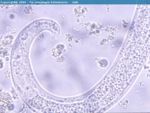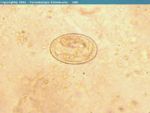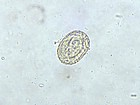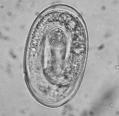Category:Metastrongyloidea
Jump to navigation
Jump to search
Also known as the 'lungworms', but beware! - not all worms in the lungs are metastrongyloids!
General Appearance
- Bursate
- Typically, look like pieces of string (some, though, are very small)
- Each species has a predilection site at some level in the respiratory tract (e.g. trachea and bronchi, bronchioles, alveolae and parenchyma) or associated blood vessels
General Life-Cycle
- The typical life-cycle is indirect, with a molluscan intermediate host
- There are some exceptions (e.g. Metastrongylus in pigs, which use earthworms as intermediate hosts, and Filaroides in dogs, which has a direct life-cycle)
- Adult female lungworms → eggs → wafted up trachea by epithelial cilia → throat → swallowed → pass through alimentary tract
- Eggs typically hatch en route → L1 in faeces
- L1 has a wavy tail and some species also have a sub-terminal peg
- L1 eaten by mollusc intermediate host → infective L3
- If small mammals or birds eat the mollusc intermediate host, the L3 of some species (e.g. Aelurostrongylus, the cat lungworm) invade the tissues and utilise the animal as a paratenic host
- The final host is infected by ingesting an intermediate or paratenic host carrying the L3
- The L3 migrate from the intestine → mesenteric lymph nodes → blood → lungs
- Prepatent period varies between species
NOTE: the most pathogenic worms in the lungs of ruminants and equines belong to the genus Dictyocaulus. These look like typical metastrongyloid lungworms, but molecular studies have confirmed that they are related to the Trichostrongyloidea (a case of convergent evolution). This explains why their life cycle is so different from the others.
- Angiostrongylus vasorum live in pulmonary arteries of dogs
- Aelurostrongylus abstrussus in lung parenchyma and small bronchioles of cats
- Metastrongylus spp. in bronchi of pigs
- Muellerius capillaris common parasite of sheep and goats in respiratory infections
- Crenosoma vulpis lungworm of dogs and foxes
Pages in category "Metastrongyloidea"
The following 5 pages are in this category, out of 5 total.




